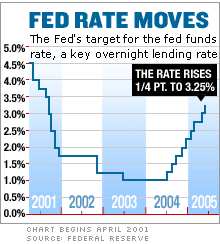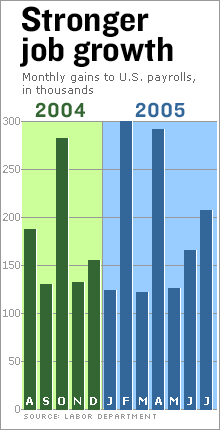 |
 |
|
|
| Old conundrum, new twist
|
| Inverted or flat, the yield curve points to a weaker Federal Reserve, not a downturn. (Full story)
|
|
|
|
|
|
|
|
|
|
NEW YORK (CNN/Money) -
Is the Federal Reserve finally ready to put away its rate-hiking boots? Probably not.
On Tuesday, the Fed is widely expected to boost the federal funds rate, which banks use to determine overnight lending rates, by a quarter of a percentage point to 3.5 percent. This would be the tenth consecutive quarter-point increase by the nation's central bank as it seeks to ward off inflation.
But Friday's stronger-than-expected July jobs report raised fresh inflation fears. More than 200,000 jobs were added and wages, which are a key factor in determining overall pricing pressures in the economy, rose at a much higher than anticipated rate.
As such, investors will eagerly glean over the Fed's statement Tuesday to see what it has to say about inflation, oil prices, the job market and economic growth in general.
Specifically, Wall Street will be watching for the following verbiage: "The Committee believes that policy accommodation can be removed at a pace that is likely to be measured." If that sentence remains, then it's almost a certainty that the Fed will raise rates at its next meeting on September 20 and perhaps again on November 1 and December 13.
And on the heels of the July labor report, several market observers said they think the Fed will keep the measured phrase, signaling more rate hikes for the rest of the year.
"After looking at the employment numbers, there is no doubt in my mind that the measured language remains. Knowing what we know now, there's no pause in 2005," said Jack Ablin, chief investment strategist with Harris Private Bank in Chicago. If that happens, the fed funds rate would end the year at 4.25 percent.
An old conundrum disappears...
Still, if the Fed keeps tightening, some worry that it may face a new "conundrum." Federal Reserve chairman Alan Greenspan and other Fed members have used that word to describe the fact that long-term bond rates have remained relatively low in the face of rising short-term interest rates.
Economists say the Fed had two reasons to worry about low longer-term rates. The yield on the 10-year Treasury sunk as low as 3.8 percent in early June, leading to worries of a flattening yield curve, the term used to describe what happens when the difference between short-term and long-term rates narrow.
Some even feared that the curve could invert, which means that short-term rates would be higher than long-term rates. That could be a problem because an inverted yield curve has tended to be a fairly accurate predictor of a recession.
The other cause for concern is that continually low long-term rates could further fuel speculation in what is already a torrid real estate market. Mortgage rates are heavily influenced by longer-term rates.
But the original conundrum may no longer be that big of a conundrum. Since the Fed's last meeting on June 30, bond prices have fallen, sending yields up from 3.94 percent to about 4.37 percent Friday morning in the wake of the July labor report.
"The economy is showing more strength and the bond market is starting to wake up to that fact," said Bill Davison, managing director of fixed income for Hartford Investment Management.
To that end, Mark Zandi, chief economist with research firm Economy.com, said the Fed might change the sentence it uses about economic risks. The Fed has maintained for some time that "the upside and downside risks to the attainment of both sustainable growth and price stability" are "roughly equal."
Translating that into English, the Fed believes the economy is neither about to slow down drastically nor heat up too much.
Zandi said there is a chance the Fed could indicate that there are now greater risks on the price stability side of the equation, i.e. more inflation. "It's almost certain that the Fed will be more upbeat about the economy," he said.
...only to be replaced by a new one?
With this in mind, some are now worried that the Fed might step up its pace of rate hikes. And that could be a problem.
"The economy is strong but not too strong," said David Kelly, economic advisor with Putnam Investments. "The right thing for the Fed to do is stay on track and raise rates 25 basis points. Any deviation from the measured pace is a mistake."
Kelly said one way the Fed could reassure investors that it is not looking to get more aggressive would be to add the word "limited" to describe its policy accommodation.
"This could indicate not a change in the pace that they are moving but that they are getting closer to their destination," said Kelly.
Ablin added that if the Fed goes too far with its rate hikes, it runs the risk of putting a big dent in the economy instead of steering it into a proverbial soft landing.
"What I worry about is that if the Fed continues to tighten, they could commit the same error they have done every time since 1980 and cause a financial crisis," said Ablin, referring specifically to the rash of savings and loan failures in the 1980s and several hedge fund blowups in 1998.
More jobs strength needed to change Fed's plans
Still, it is probably premature to worry about a significantly more aggressive Fed. Zandi said the Fed has been so transparent during this round of rate hikes that it would truly be shocking for them to depart from its plan now.
"The Fed has been laying down a script and sticking to it. This reduces the odds of them overdoing it and creating a financial problem," he said, adding that a fed funds rate of 4.25 percent by year's end is a reasonable expectation.
Davison agreed that the central bank is unlikely to stop raising interest rates any time this year. He adds that the July jobs figures, while strong, were not "knock your socks off" numbers. So the market doesn't need to worry about rampant inflation.
"We would have to see a number much higher than July's for the Fed to think about raising rates by 50 basis points. We would need to have job gains of 350,000 to 400,000 more than one time," he said.
For more about the July jobs report, click here.
For a look at bond rates, click here.

|